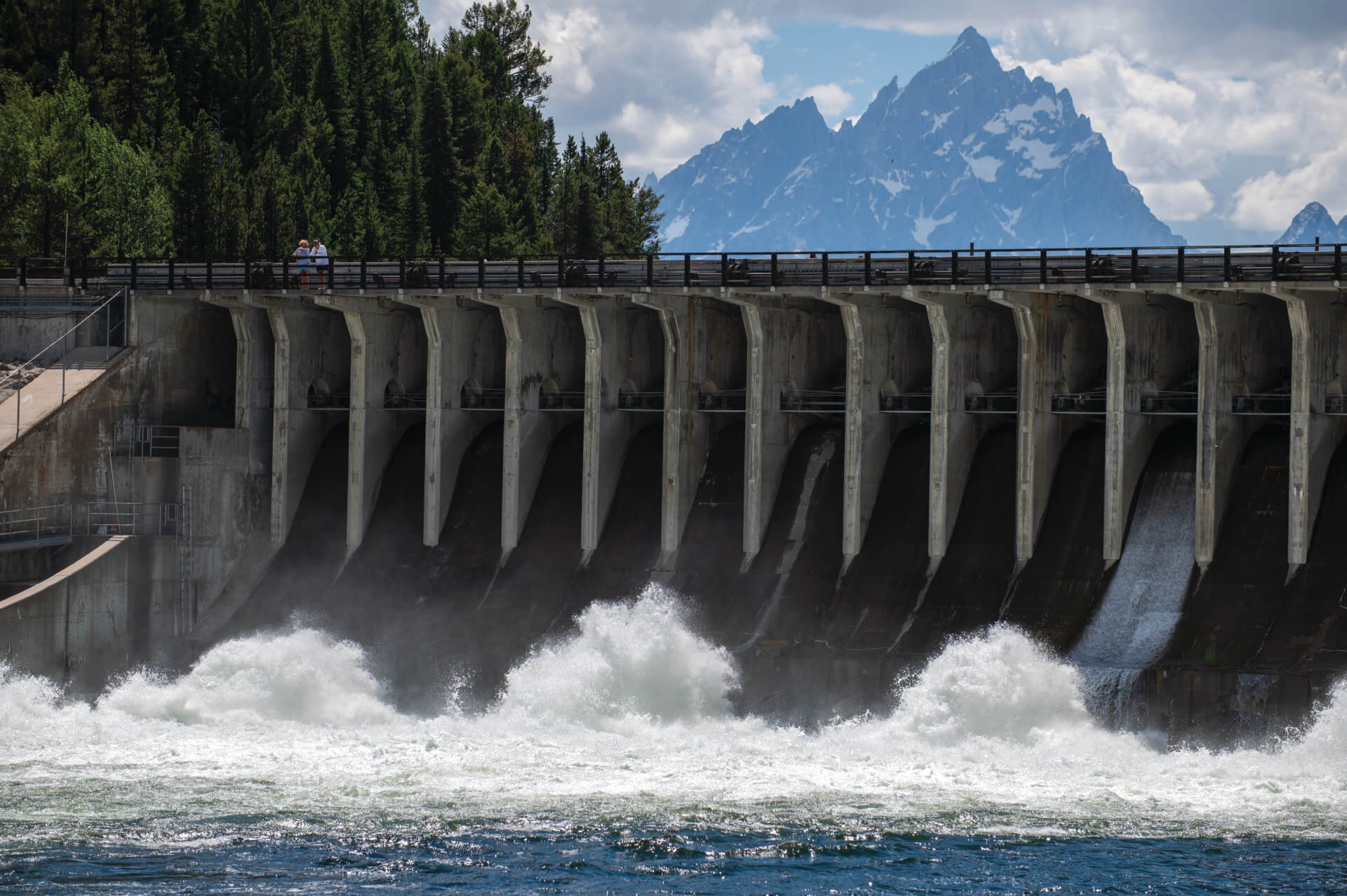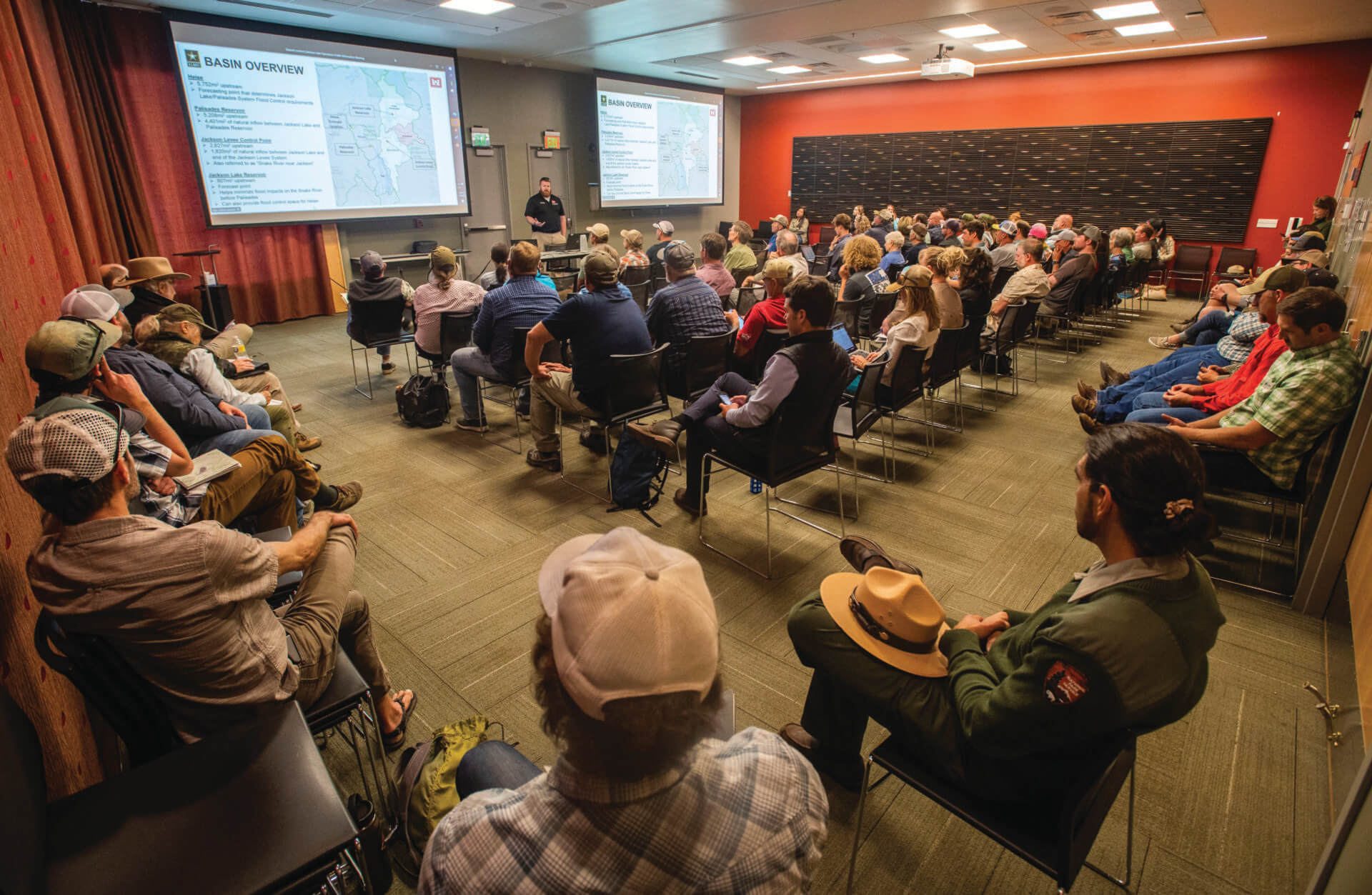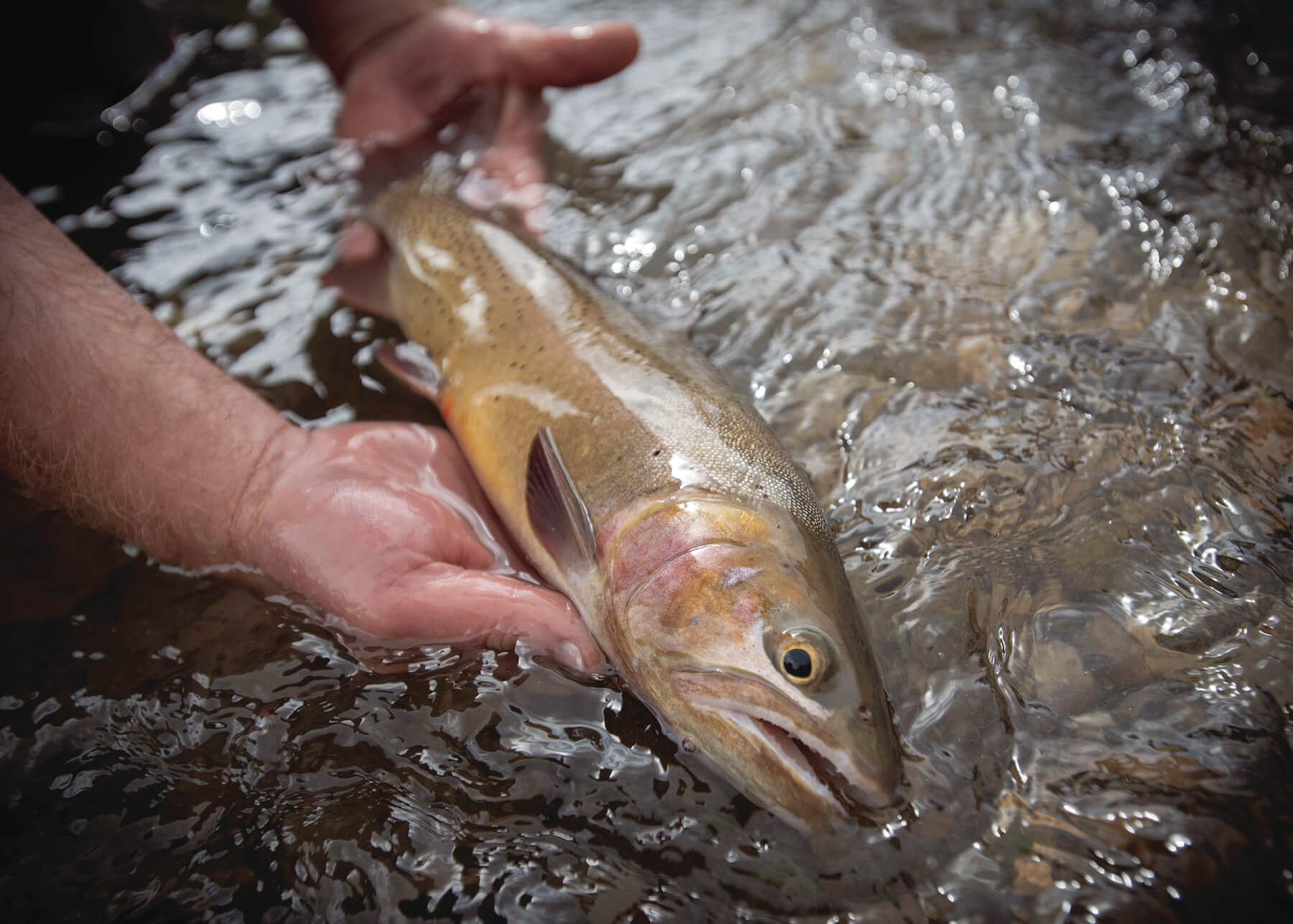Read The
Current Issue
The Ways of Water
Laws say that water in the West must be put to “beneficial use.” Historically, that has meant agriculture, but could recreation and ecosystem health enter the conversation?
// By Molly Absolon
// photography by bradly j. boner

One of the most visited places in Jackson Hole is the Snake River’s Oxbow Bend. Here you can see Mount Moran reflected in the bend’s still waters, watch the pink alpenglow of sunrise light up the Tetons, catch a glimpse of a moose bedded down in the willows, sight a grizzly bear wandering along the shoreline, or land a native cutthroat trout on a dry fly. In the Oxbow, the river is quiet, slowed by its curve to the north, in sharp contrast to the more rambunctious character it exhibits farther south in the whitewater of the Snake River Canyon, just above the town of Alpine. Along the Oxbow, the silence is broken only by birdsong and the gentle lapping of water against the shoreline.
For many, this section of the Snake River captures the essence of Jackson Hole, with its framework of jagged mountains, its abundant and diverse wildlife, and the in-your-face drama of the scenery. It feels wild, untouched, and protected—or so many of us assumed until May 2023, when the Bureau of Reclamation—the agency established by the federal government in 1902 to “manage, develop, and protect water and related resources”—announced it intended to drop flows from Jackson Lake Dam, just upstream from the Oxbow, to 50 cubic feet per second (cfs), essentially dewatering the feature.
Flow rates in the Snake have always fluctuated, with natural peaks occurring anytime from mid-May to mid-June, depending on snowpack and temperature. Under Reclamation’s management, water releases from the dam vary in timing and amount according to downriver irrigation needs. Typically, the range is between highs of around 3,000 cfs to lows of 280, a flow rate determined in the 1980s to be the minimum necessary to sustain aquatic life in the Oxbow.

Every year, Reclamation drops the level of the river, known as a drawdown, to provide water for irrigation. In 2021, those autumn drawdowns were done so rapidly—3,000 to 280 cfs in the span of a week—that fish were stranded in dried-up channels, causing an outcry among anglers and fisheries biologists. In 2022, there were artificially high flows—releases at the dam ranged from 1,750 to 2,250 cfs from April through September—which kept whitewater boaters entertained long past the typical highwater season but left Jackson Lake nearly empty, its marinas stranded well above the waterline.
Cracked mud shorelines along Jackson Lake juxtaposed simultaneously with raging rapids in Snake River Canyon are indicative of just how far from natural the Snake River is, despite its wild and pristine façade. Every drop of water between its banks—every drop of water in most Western waterways—is allocated in some way.
Jackson Lake Dam’s sole purpose is to store and release water to irrigate crops in Idaho. The dam, originally constructed in 1906–1907 and replaced in stages between 1911 and 1916, raised water levels in an existing natural lake by 30 feet and created storage capacity for 847,000 acre feet of water. (An average family uses 0.25 acre feet of water per year.) Idaho owns 96 percent of the water stored in Jackson Lake; Wyoming controls the remaining 4 percent.

Jackson Lake Dam is managed and operated by the Bureau of Reclamation, which has constructed more than 600 dams and reservoirs in the Western United States since its inception. The agency is credited with promoting the economic development of the West though its water projects and is the country’s largest wholesaler of water and its second largest producer of hydroelectric power. A part of the Department of the Interior, Reclamation has a memorandum of understanding with its sister agency, the National Park Service, for managing Jackson Lake, which lies within Grand Teton National Park’s boundaries, although the park itself was created in 1929, 13 years after the dam was completed.
The Snake River Plain receives less than 12 inches of rain annually. Thanks to irrigation from its namesake river, it is able to help produce $15 billion of agriculture every year.
Water has been viewed as a coveted resource ever since Europeans first began settling the arid West in the 1800s. Water law varies from state to state, but the general rule is that of prior appropriation, or “first in time, first in use,” meaning senior water users, or those who were the first to divert and develop the water resource, have priority, regardless of their location.

For the Snake River, the senior water users are the irrigators in Idaho who’ve had claim to the river since they helped pay to build Jackson Lake Dam more than 100 years ago. Water rights are purchased once—many Idaho irrigators have held their rights for multiple generations—after which they can be bought and sold though what’s being bought and sold is a right to use the water, not own it. Historically, surface and groundwater were treated separately. Now, as the hydrological links between the two have become clear, many water districts are being forced to consider both surface and groundwater together, adding to the complexity of the system.
The second part of Western water doctrine is that the water must be put to “beneficial use.” Water that is not used beneficially is considered wasted, and wasted water can lead to the forfeiture of water rights. (Hence the expression “use it or lose it.”)
“It’s the state’s water,” says Idaho House Rep. Stephanie Jo Michelsen of Idaho Falls. Michelsen’s family owns a number of farms and ranches in eastern Idaho that rely on the Snake River (both surface and groundwater) for irrigation. “The state issues the water rights, so you have a right to use it, but you don’t own it. You are required to use the water for the maximum benefit of all users. It’s important for people to look at the water as a resource and to try to manage it as a beneficial use for everyone.”
Just what defines a beneficial use is the rub. For ranchers and farmers, that definition is obvious. Water is critical to allowing the desert to bloom, and, therefore, its best use is for irrigation. According to the Idaho Department of Water Resources, the Snake River Plain’s agriculture is worth roughly $15 billion per year—that’s in an area that averages less than 12 inches of rain annually. Idaho’s agribusiness accounts for 20 percent of that state’s GDP. Seventy-four percent of all agribusiness in Idaho is located along the Snake River.

Despite the fact that Reclamation manipulates flows in the Snake down to the very last trickle, the river remains quite healthy in its upper reaches through Jackson Hole. Though not without issues, overall it is remarkably clean and an important component of the Greater Yellowstone Ecosystem, the largest intact ecological unit in the Lower 48 states.
Leslie Steen, the Wyoming program director for Trout Unlimited, a national nonprofit with the mission of “bringing together diverse interests to care for and recover rivers and streams so our children can experience the joy of wild and native trout and salmon,” says, “The Upper Snake is unique in that it has a healthy, stable native cutthroat trout population.”
“We are surrounded by highly compromised, nonintact watersheds,” Steen told Jackson Hole magazine reporter Mike Koshmrl in 2020. “They’re great fisheries, but they are not like what we have in [Jackson Hole]. As time goes by and the climate warms, this might be one of the last best places for cutthroat, if we can hang onto it.”
It’s not just cutthroat. The Snake provides critical habitat for a broad spectrum of plants and animals. All the native wildlife species that traditionally inhabited this stretch of river—with the exception of the northern leopard frog—still live here and are self-sustaining. The river supports the largest elk herd in the world, as well as grizzly bears and wolves, trumpeter swans, common loons, and nesting populations of bald eagles and peregrine falcons.
Thousands of boaters and anglers float the Snake in Jackson Hole every summer. People walk along its banks, exercising their pets, socializing with friends and looking for birds and wildlife. The river is a focal point—a place where people go to relax, recreate, and find spiritual solace and renewal. In Idaho, that experience is different. The Snake that flows from the Wyoming border to Oregon is so polluted by agricultural runoff that public health officials routinely warn people not to recreate in it and recommend against consuming fish from its waters. The Snake’s native salmon runs, which were once prized, are now threatened with extinction.
“The Snake River in Wyoming is very different from the Snake River in Idaho,” says Scott Bosse, the Northern Rockies director of American Rivers, a nonprofit that works to protect and restore rivers throughout the country. “We saw this whole conflict between Wyoming and Idaho during our campaign to protect the [Snake River] headwaters as Wild and Scenic [in 2007 and 2008]. It boiled down to people in Wyoming who wanted a free-flowing river for wild and scenic values, and those in Idaho who saw the Snake as a big ditch to benefit ranchers and farmers.”
While the economic benefit to Idaho agriculture is easy to put a price tag on, it’s more difficult to put specific numbers on the economic impact of the uses—recreation, fisheries, limited irrigation, and healthy riparian ecosystems—associated with the Snake River in Jackson Hole. The outdoor recreation income for the entire state of Wyoming was valued at $2.2 billion in 2022, according to the U.S. Department of Commerce’s Bureau of Economic Analysis. That equates to 4.1 percent of Wyoming’s gross domestic product.
Fly fishing is also important to Jackson Hole, supporting numerous businesses and creating hundreds of jobs. What that means monetarily is unclear, though. The fly fishing industry for all of North America is valued at $75 million, a fraction of the billions that potatoes, dairy, sugar beets, alfalfa, wheat, and trout farming bring into Idaho.
But is it just dollars that determine value? As Trout Unlimited’s Steen points out with the native fish in the Snake, Jackson Hole’s relatively intact ecosystem supports things that are hard to put a monetary figure on. Here we have clean water, intact fisheries, healthy wildlife populations, outstanding opportunities for recreation, and scenic splendor. These things feed our economy and sustain us in immeasurable ways. They allow us to experience the solace of nature and to enjoy the wellbeing that comes from living a healthy lifestyle in the outdoors. They provide jobs and support local businesses. They are also threatened by climate change, population growth, and invasive species, which have many people in Jackson Hole convinced that leaving water in the river should be considered as important as using it for irrigation.
“When the majority of water rights in our region were allocated, there was not much concern for the overall health of the Snake River watershed or rivers in general,” says Aaron Pruzan, owner of Rendezvous River Sports and a kayaker and river advocate. “While we have all benefited from the impressive agricultural production on the Snake River Plain—and I respect the value of irrigation being tied to the land—we must develop a more balanced approach moving forward that also respects the value of clean, free-flowing water. The arteries of the ecosystems are of critical importance to the native plants and animals and the river recreation that makes the Snake headwaters region thrive, and they need to be treated as such.”
Pruzan says we’ve learned a lot since the first dams were built on the Snake more than 100 years ago. Even as recently as the 1970s, when he was a kid, no one thought salmon would be brought to the brink of extinction in the Northwest; now we know they are struggling as a result of human-caused changes to rivers. Dams hailed as incredible feats of engineering—which Pruzan acknowledges they are—have caused devastating ecological impacts that were ignored or unknown for decades.
“It is remarkable that water-resources solutions from over a century ago continue to provide enormous value to an agricultural economy that not only serves our nation, but serves the world,” says Michael Coffey, a Bureau of Reclamation public affairs officer for the Columbia-Pacific Northwest Region. “At the same time, those solutions are not static. Reclamation continually adapts to changing environmental, social, and economic conditions through ever-evolving scientific information and decision-making tools with the goal of providing value long into the future.”
“There is certainly not going to be more water—most models predict less—and there is pretty strong resistance from water-rights owners to give any of it up.”
—Darren Rhea, regional fisheries supervisor for the Wyoming Game and Fish Department
Yet, there’s an inherent conflict between Reclamation’s ability to adapt and its contractual obligations. The authorized purpose of Jackson Lake Dam is irrigation, and Reclamation is legally bound to deliver water to the farmers and ranchers who own the rights to it. With a fully allocated river and thirsty farms waiting for their water downstream, there isn’t a lot of wiggle room for keeping flows in the upper Snake to support recreation, fisheries, and ecosystem health. Finding ways to maintain flows in the Snake’s upper reaches means finding ways to tweak the system while still delivering water downstream.
“I’d like to say that we have this figured out,” says Paul Arrington, the executive director and general counsel at the Idaho Water Users Association, a group formed in 1937 that today represents irrigation water users, municipalities, hydropower, aquaculture, agribusinesses, and businesses interested in the perpetuation of wise water use in Idaho and the coutry. “But it is a work in progress. There are ongoing and significant disputes all along the [Snake River] Plain about the impacts of groundwater pumping on the overall water supply. We struggle with shifting precipitation patterns and how they impact our ability to store water. We are engaging in recharge and cloud seeding to help shore up resources.”
The Idaho Water Users Association is just one of the many groups and agencies that have a stake in the future of the Snake River. To help coordinate these groups, a new coalition of federal and state agencies, conservation groups, nonprofits, and other stakeholders was created in 2023. Dubbed the Snake River Headwaters Watershed Group, the coalition is dedicated to ensuring the Snake remains a healthy and resilient river into the future.
“The Watershed Group is not a vehicle to change water law, it’s a vehicle to find common interests and share information,” says Yvette Converse, the chief of science and resource management at Grand Teton National Park. Converse represents the park in the Watershed Group and was active in its design phase last year. “Another reason the Watershed Group is good is that sometimes it’s not that things aren’t happening, it’s that if we don’t know they are happening, it’s almost like they aren’t happening,” she says. “The group helps us know what everyone is doing and how we fit together.”
Water flows are just part of what the Watershed Group will address. Working groups have been formed to look at management, ecosystems, data and monitoring, and outreach and community engagement. Still, flows are a big part of the equation.
“There is certainly not going to be more water—most models predict less—and there is pretty strong resistance from water-rights owners to give any of it up,” says Darren Rhea, the regional fisheries supervisor for the Wyoming Game and Fish Department, who has also been involved in the formation of the Watershed Group. “There may be opportunities to buy or sell water, but that seems likely to be cost prohibitive. I see our best opportunity for flexibility being in how water is managed, stored, and moved through the system. Timing seems to be the bandwidth where some solutions for the future exist.”
“The Snake River is a super complex system,” says American Rivers’ Bosse. “There’s a water lawyer for every acre foot of water in the river. But the day is coming when we will have to sit down and reconsider water management. It’s going to be a long, probably decades-long, process. The Snake River flows for over 1,000 miles through Wyoming, Idaho, Washington, and Oregon—four different states with lots of complexities, lots of different agencies, lots of different stakeholders. What is doable, especially if you live in northwest Wyoming, is to guarantee there is enough water flowing below Jackson Lake Dam. I think we can solve that problem. It’s taking a relatively small bite out of a huge issue.” JH




